St Albans and Mid-Herts Hospital
Church Crescent, St Albans, Herts AL3 5JF
Medical
dates:
Medical
character:
Acute
The St Albans and Mid Herts
Hospital originated from a free dispensary - the St Albans General
Dispensary - located in a rented house in St Albans. It had been
established in the first part of the 19th century by local medical
practitioners. In 1843 it had 7 beds. Later, the Dispensary
moved to new premises adjoining Holywell Hill, the site of which had
been acquired in 1861.
In 1887 a new 1-acre site on the corner of Verulam Road and Church Crescent was purchased for £750 in order to build a larger hospital.
The new St Albans and Mid-Herts Hospital and Dispensary opened in 1888, the first purpose-built hospital in the town. The 2-storey red brick building had cost about £3,750 to erect. The former Dispensary building was sold for £910 and the remainder of the cost had been raised by subscriptions to a Building Fund.
In 1899 the Hospital was enlarged and improved, at a cost of £1,800.
The Hospital was enlarged again in 1912, after which it had 40 beds. Additions had been made to the male and female wards, so that each had 2 extra beds. A new ward had been built over the female ward, which could contain either 10 beds or 15 cots. The bathrooms had been reconstructed with new bathtubs. An isolation ward had also been built, as well as additional nurses' accommodation. A spacious verandah had been added to the south side of the Hospital; this could be used an open air ward. However, the kitchen and larder were untouched and remained inadequate, as was the mortuary, which still had to be used as the post-mortem room; the Hospital also lacked a chapel and a view room.
During WW1 (1914-1918) regular subscriptions to the Hospital fell. By 1918 its funds were in deficit. Running costs had almost doubled during the war. The Hospital was saved financially by generous donations from wealthy benefactors.
By 1927, as the number of cars increased on the roads, the number of admissions due to road traffic accidents was 'becoming formidable'.
In 1928 the Hospital had 50 beds. The weekly cost of an in-patient was £3 1s 5d (£3.07), compared with £3 3s 8d (£3.18) in 1928. Thirty five percent of cases (160 patients) admitted were due to accidents and injuries. Of these 160, 121 were due to road traffic accidents.
The X-ray Department was reorganised in 1928 at a cost of £1,300. An additional wing was built at the westerly end of the Hospital. This contained a large X-ray room, a darkroom and a waiting room. The new powerful equipment with a high tension transformer could radiograph all parts of the body, including special examinations of the heart, lungs and intestinal tract.
By 1938 the Hospital was a general hospital for medical and surgical cases and accidents. It had an operating theatre and an X-ray Department. Its medical staff consisted of 8 Honorary Medical Officers, several Honorary Consulting Surgeons, an Honorary Dental Surgeon, an Honorary Radiologist, an Honorary Psychiatrist and a Resident House Surgeon.
During WW2 (1939-1945) the Hospital joined the Emergency Medical Service.
Presumably extended during the war, in 1947 it had 75 open beds.
In 1948 the Hospital joined the NHS under the control of the Mid Hertfordshire Group Hospital Management Committee, part of the North West Metropolitan Regional Hospital Board. It had 110 beds - 95 for general patients and 15 for the chronic sick.
In 1950 it amalgamated with Osterhills Hospital to form the St Albans City Hospital, of which it became the Mid-Herts Wing.
In 1974, following a major reorganisation of the NHS, the Hospital came under the control of the North West Herts District Health Authority, part of the North West Thames Regional Health Authority.
In 1983 the Hospital had 58 beds for geriatric patients.
It closed in 1990.
In 1887 a new 1-acre site on the corner of Verulam Road and Church Crescent was purchased for £750 in order to build a larger hospital.
The new St Albans and Mid-Herts Hospital and Dispensary opened in 1888, the first purpose-built hospital in the town. The 2-storey red brick building had cost about £3,750 to erect. The former Dispensary building was sold for £910 and the remainder of the cost had been raised by subscriptions to a Building Fund.
In 1899 the Hospital was enlarged and improved, at a cost of £1,800.
The Hospital was enlarged again in 1912, after which it had 40 beds. Additions had been made to the male and female wards, so that each had 2 extra beds. A new ward had been built over the female ward, which could contain either 10 beds or 15 cots. The bathrooms had been reconstructed with new bathtubs. An isolation ward had also been built, as well as additional nurses' accommodation. A spacious verandah had been added to the south side of the Hospital; this could be used an open air ward. However, the kitchen and larder were untouched and remained inadequate, as was the mortuary, which still had to be used as the post-mortem room; the Hospital also lacked a chapel and a view room.
During WW1 (1914-1918) regular subscriptions to the Hospital fell. By 1918 its funds were in deficit. Running costs had almost doubled during the war. The Hospital was saved financially by generous donations from wealthy benefactors.
By 1927, as the number of cars increased on the roads, the number of admissions due to road traffic accidents was 'becoming formidable'.
In 1928 the Hospital had 50 beds. The weekly cost of an in-patient was £3 1s 5d (£3.07), compared with £3 3s 8d (£3.18) in 1928. Thirty five percent of cases (160 patients) admitted were due to accidents and injuries. Of these 160, 121 were due to road traffic accidents.
The X-ray Department was reorganised in 1928 at a cost of £1,300. An additional wing was built at the westerly end of the Hospital. This contained a large X-ray room, a darkroom and a waiting room. The new powerful equipment with a high tension transformer could radiograph all parts of the body, including special examinations of the heart, lungs and intestinal tract.
By 1938 the Hospital was a general hospital for medical and surgical cases and accidents. It had an operating theatre and an X-ray Department. Its medical staff consisted of 8 Honorary Medical Officers, several Honorary Consulting Surgeons, an Honorary Dental Surgeon, an Honorary Radiologist, an Honorary Psychiatrist and a Resident House Surgeon.
During WW2 (1939-1945) the Hospital joined the Emergency Medical Service.
Presumably extended during the war, in 1947 it had 75 open beds.
In 1948 the Hospital joined the NHS under the control of the Mid Hertfordshire Group Hospital Management Committee, part of the North West Metropolitan Regional Hospital Board. It had 110 beds - 95 for general patients and 15 for the chronic sick.
In 1950 it amalgamated with Osterhills Hospital to form the St Albans City Hospital, of which it became the Mid-Herts Wing.
In 1974, following a major reorganisation of the NHS, the Hospital came under the control of the North West Herts District Health Authority, part of the North West Thames Regional Health Authority.
In 1983 the Hospital had 58 beds for geriatric patients.
It closed in 1990.
Present status (January 2009)
The site of the Hospital remains in institutional use. Extensions to the original building have been removed, as have some of the original outbuildings.
In 1993 the northern part of the site was cleared for Albany Lodge to be built. The community treatment centre has 24 beds.
The southern part of the site is occupied by the St Albans Children's Centre, which uses the original Hospital building.
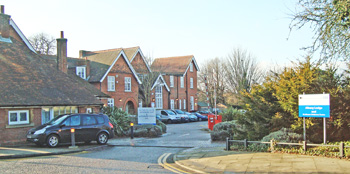
The driveway leading to the Children's Centre and Albany Lodge.
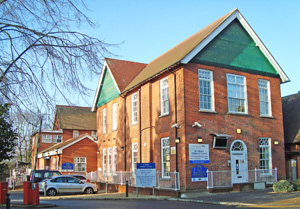
The locally listed building, facing Verulam Road, was built in the Queen Anne style. It has been altered and extended over the years.
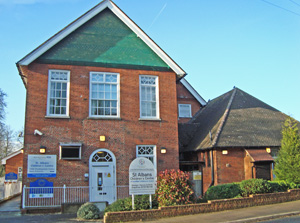
The gable end with the main entrance in Church Crescent. The small 1-storey lodge, built of similiar materials, is also locally listed.
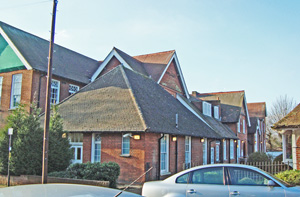
The back of the building, as seen from Church Crescent.
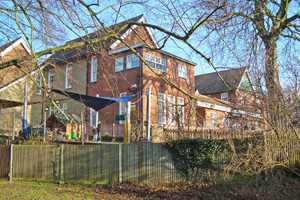
The former Hospital, as seen from the park off Verulam Road.
Burdett H 1914 The St Albans and Mid-Herts Hospital. Hospital 55 (1443), 559.
Mein J, Wares A, Mann S (eds) 2016 St Albans: Life on the Home Front, 1914-1918. Hatfield, Hertfordshire Publications.
Paton RRK 1938 Annual report of the Medical Officer of Health. St Albans, City of St. Alban., 11.
Sleigh JC 1949 Annual Report of the Medical Officer of Health. St Albans Rural District Council, 18-19.
Sleigh JC 1949 Annual Report of the Medical Officer of Health. St Albans, Harpenden Urban District Council, 16.
Winn Everett G 1959 Health Report. Borehamwood, Elstree Rural District, 8.
http://archive.historicengland.org.uk (1)
http://archive.historicengland.org.uk (2)
http://archive.historicengland.org.uk (3)
http://archive.historicengland.org.uk (4)
http://archive.historicengland.org.uk (5)
http://edithsstreets.blogspot. com
http://lifetimenurse.blogspot.co.uk
www.a1taxis.net
www.british-history.ac.uk
www.haroldbeck.org.uk
www.stalbans.gov.uk
Return to home page